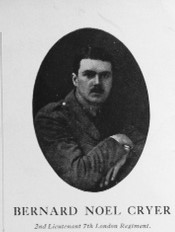2nd Lt
Bernard Noel Cryer
Informationen zu Geburt
|
Geburtsdatum: 25/12/1892 |
|
Geburtsort: Ealing, Middlesex, England, Vereinigtes Königreich |
Informationen zum Armeedienst
|
Land: England, Vereinigtes Königreich |
|
Truppe: British Expeditionary Force |
|
Rang: Second Lieutenant |
|
Dienstnummer: / |
|
Einberufung datum: 15/09/1914 |
|
Einheiten: — London Regiment, 1/7th Bn. (Letzte bekannte Einheit) |
Informationen zu Tod
|
Sterbedatum: 15/09/1917 |
|
Sterbeort: Cryer Farm, Belgien |
|
Todesursache: Im Kampf gefallen |
|
Alter: 24 |
Gedenkstätte
|
Ypres (Menin Gate) Memorial Tafel: 54 |
Auszeichnungen und Orden 3
|
British War Medal Medaille |
|
Mentioned in Despatches Honourable mentioning |
|
Victory Medal Medaille |
Punkte von Interesse 1
| #1 | Geburtsort |
Meine Geschichte
Second Lieutenant Bernard Noel Cryer was part of the 7th (City of London) Battalion of the London Regiment, 47th Division, 140th Brigade. On the 14th of September 1917 the Battalion was holding the line near Clapham Junction. At 4:10 p.m. on the 15th of September, a raid party went over the top and attacked the German bunker located about 300 meters east of Clapham Junction (halfway between Glencorse Wood and Inverness Copse). The objective to capture and hold this position was successful. Second Lieutenant Bernard Noel Cryer took part in the raid and was killed by a shell in the attack. It is mentioned that he was buried there and his grave marked by a cross. After the war his body was not recovered. In his memory, the position was renamed Cryer Farm.
Before its capture the Germans used the bunker as a dressing station. It was built along the railway line and important communication trenches fort his purpose. As the British pushed the front line east during the Thrid Battle of Ypres, the bunker was transformed by the Germans into a heavily defended strongpoint.
After the war nature reclaimed the bunker, but it was put back into use in the Second World War as an air raid shelter. Thereafter the bunker was used as a cesspool for a local farm until 1985. After some interest from the landowners, an archaeological excavation was undertaken in December 2001. The site has been open for the public since Novermber 2002. Today group visits can still be made after the reservation.
Before its capture the Germans used the bunker as a dressing station. It was built along the railway line and important communication trenches fort his purpose. As the British pushed the front line east during the Thrid Battle of Ypres, the bunker was transformed by the Germans into a heavily defended strongpoint.
After the war nature reclaimed the bunker, but it was put back into use in the Second World War as an air raid shelter. Thereafter the bunker was used as a cesspool for a local farm until 1985. After some interest from the landowners, an archaeological excavation was undertaken in December 2001. The site has been open for the public since Novermber 2002. Today group visits can still be made after the reservation.
Quellen 4
|
140 Infantry Brigade: 1/7 Battalion London Regiment (City of London). (The National Archives, KEW (TNA), WO 95/2730/4). https://discovery.nationalarchives.gov.uk/details/r/C14303 Verwendete Quellen |
|
Bostyn Franky, Cryer Farm: Excavation and restoration of a WW1 German Dressing Station on the Ypres-Menin Road, Battlefields Annual Review, (Barnsley, Pen and Sword), p 87-94. Verwendete Quellen |
|
Planck C.Digby, History of the 7th (City of London) Battalion the London Regiment, (London, The Old Comrades' association, 1946), p 124-127. Verwendete Quellen |
|
Vancoillie Jan, Bostyn Franky and Pauwels Marcel, Halfweg Menin Road en Ypernstrasse : Gheluvelt 1914-1918, (Association for Battlefiled Archaelogy in Flanders, 2002), p 302-303. Verwendete Quellen |
Weitere Informationen 3
|
Commonwealth War Graves Commission Database https://www.cwgc.org/find-records/find-war-dead/casualty-details/1608689 |
|
Namenlijst (In Flanders Fields Museum) https://namenlijst.org/publicsearch/#/person/_id=9177b8c6-5afa-41b6-85b6-a6c9387f02b7 |
|
Lives of the First World War (Imperial War Museum) https://livesofthefirstworldwar.iwm.org.uk/lifestory/1047224 |
